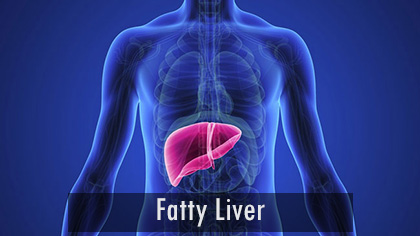The liver is the largest internal organ of the body and it plays a critical role in food digestion, removing poisons from the system and storing energy. When fat deposits build up in the liver the condition is known as Fatty Liver Disease and it can have serious consequences. Fatty Liver Disease can take two forms – Nonalcoholic Fatty Liver Disease and Alcoholic Fatty Liver Disease.
Non-alcoholic Fatty Liver Disease
This type of condition appears in two forms. If it is simple fatty liver, there are fat deposits in the organ but they do not cause any liver cell damage or inflammation. This condition typically does not cause damage to the liver and there are no complications. The other form is called Nonalcoholic Steatohepatitis (NASH) and in this case, there is fat in the liver, inflammation and liver cell damage. This inflammation and/or damage to the liver cells could cause scarring of the liver which could affect its functioning.NASH can also lead to liver cancer or cirrhosis. Those most at risk of contracting this condition include people who:

- Have type 2 diabetes or prediabetes.
- Are seriously overweight.
- Are middle aged or older (although rare, children can also be affected by this condition).
- Have high blood pressure.
- Take drugs such as corticosteroids or anti-cancer medications.
- Have high levels of fat in their blood.
- Have had infections like hepatitis C.
- Suffer from metabolic disorders.
- Have been exposed to toxins of various kinds.
Also Read: What is Fatty Liver Disease?
Alcoholic Fatty Liver Disease
As the name suggests, this is caused by excessive consumption of alcohol. When alcohol is consumed, it needs to be broken down so it can be removed from the system. In the process, a range of harmful by-products are produced which cause damage to the liver cells, inflammation and affect the functioning of the organ. The more alcohol consumed, the faster the damage occurs.Alcoholic fatty liver disease is the first stage of very serious medical conditions like hepatitis, cirrhosis and liver cancer.
Signs And Symptoms
There are few obvious symptoms of both forms of the disease. In some cases, a person may feel unusually tired or weak or feel some discomfort on the upper right side of the abdomen. The existence of this condition can be confirmed by an examination of a person’s medical history, physical examination and the results of a range of pathological tests.
Also Read: Role of Liver Biopsy in Managing Fatty Liver Disease
Treatment
There are no medications that have been proven to definitely help in treating fatty liver disease. In the case of the non-alcoholic condition, doctors usually recommend weight loss, a controlled exercise regimen and if medication is a contributing factor, the replacement of that medicine with an alternative that does not hurt the liver. If the condition is caused by alcohol consumption, stopping the drinking is essential. Joining an alcohol recovery programme or seeing a therapist for severe alcohol addiction can be helpful. There are also some medicines that can reduce the craving for liquor. For both conditions, a doctor will prescribe lifestyle changes which will lower the load on the liver.

